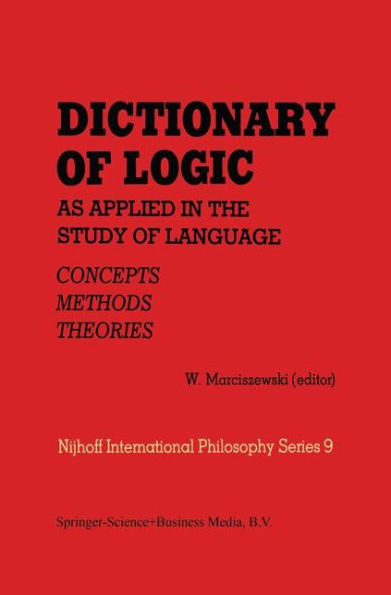Dictionary of Logic as Applied in the Study of Language: Concepts/Methods/Theories
1. STRUCTURE AND REFERENCES 1.1. The main part of the dictionary consists of alphabetically arranged articles concerned with basic logical theories and some other selected topics. Within each article a set of concepts is defined in their mutual relations. This way of defining concepts in the context of a theory provides better understanding of ideas than that provided by isolated short defmitions. A disadvantage of this method is that it takes more time to look something up inside an extensive article. To reduce this disadvantage the following measures have been adopted. Each article is divided into numbered sections, the numbers, in boldface type, being addresses to which we refer. Those sections of larger articles which are divided at the first level, i.e. numbered with single numerals, have titles. Main sections are further subdivided, the subsections being numbered by numerals added to the main section number, e.g. I, 1.1, 1.2, ... , 1.1.1, 1.1.2, and so on. A comprehensive subject index is supplied together with a glossary. The aim of the latter is to provide, if possible, short defmitions which sometimes may prove sufficient. As to the use of the glossary, see the comment preceding it.
1100934279
Dictionary of Logic as Applied in the Study of Language: Concepts/Methods/Theories
1. STRUCTURE AND REFERENCES 1.1. The main part of the dictionary consists of alphabetically arranged articles concerned with basic logical theories and some other selected topics. Within each article a set of concepts is defined in their mutual relations. This way of defining concepts in the context of a theory provides better understanding of ideas than that provided by isolated short defmitions. A disadvantage of this method is that it takes more time to look something up inside an extensive article. To reduce this disadvantage the following measures have been adopted. Each article is divided into numbered sections, the numbers, in boldface type, being addresses to which we refer. Those sections of larger articles which are divided at the first level, i.e. numbered with single numerals, have titles. Main sections are further subdivided, the subsections being numbered by numerals added to the main section number, e.g. I, 1.1, 1.2, ... , 1.1.1, 1.1.2, and so on. A comprehensive subject index is supplied together with a glossary. The aim of the latter is to provide, if possible, short defmitions which sometimes may prove sufficient. As to the use of the glossary, see the comment preceding it.
219.99
Out Of Stock
5
1

Dictionary of Logic as Applied in the Study of Language: Concepts/Methods/Theories
436
Dictionary of Logic as Applied in the Study of Language: Concepts/Methods/Theories
436
219.99
Out Of Stock

Product Details
| ISBN-13: | 9789024721238 |
|---|---|
| Publisher: | Springer Netherlands |
| Publication date: | 07/31/1981 |
| Series: | Melbourne International Philosophy Series , #9 |
| Edition description: | 1981 |
| Pages: | 436 |
| Product dimensions: | 6.10(w) x 9.25(h) x 0.04(d) |
From the B&N Reads Blog
